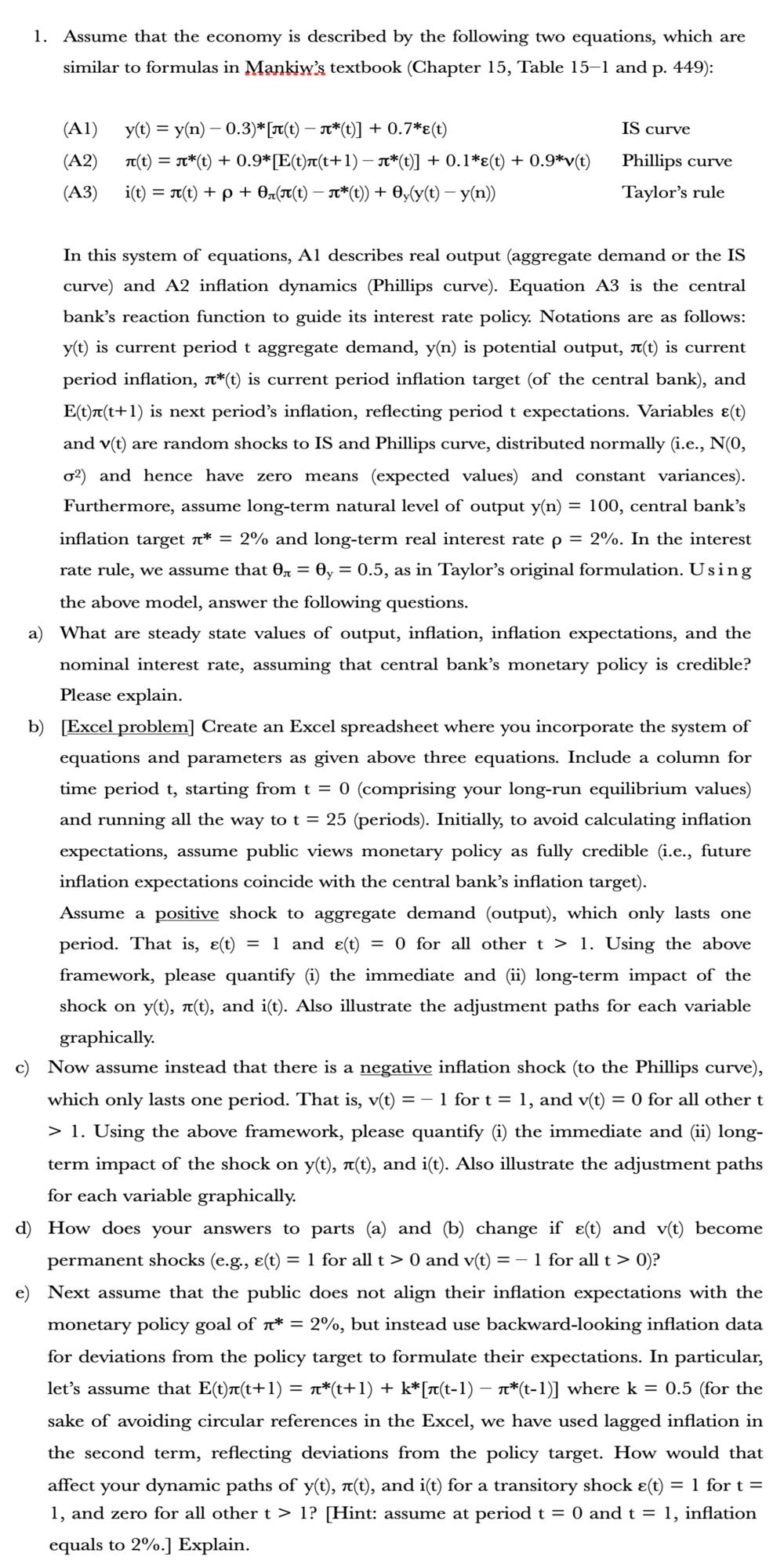Answered step by step
Verified Expert Solution
Question
1 Approved Answer
1. Assume that the economy is described by the following two equations, which are similar to formulas in Mankiw's textbook (Chapter 15, Table 15-1

1. Assume that the economy is described by the following two equations, which are similar to formulas in Mankiw's textbook (Chapter 15, Table 15-1 and p. 449): (Al) y(t) = y(n) - 0.3)*[(t) *(t)] +0.7*(t) (A2) (t) = *(t) + 0.9*[E(t)(t+1) *(t)] + 0.1*(t) + 0.9*v(t) (A3) i(t) = n(t) + p + 0((t) *(t)) + y(y(t) y(n)) IS curve Phillips curve Taylor's rule In this system of equations, Al describes real output (aggregate demand or the IS curve) and A2 inflation dynamics (Phillips curve). Equation A3 is the central bank's reaction function to guide its interest rate policy. Notations are as follows: y(t) is current period t aggregate demand, y(n) is potential output, (t) is current period inflation, *(t) is current period inflation target (of the central bank), and E(t)r(t+1) is next period's inflation, reflecting period t expectations. Variables &(t) and v(t) are random shocks to IS and Phillips curve, distributed normally (i.e., N(0, 2) and hence have zero means (expected values) and constant variances). Furthermore, assume long-term natural level of output y(n) 100, central bank's inflation target * = 2% and long-term real interest rate p = 2%. In the interest rate rule, we assume that 0 = 0y = 0.5, as in Taylor's original formulation. Using the above model, answer the following questions. a) What are steady state values of output, inflation, inflation expectations, and the nominal interest rate, assuming that central bank's monetary policy is credible? Please explain. b) [Excel problem] Create an Excel spreadsheet where you incorporate the system of equations and parameters as given above three equations. Include a column for time period t, starting from t = 0 (comprising your long-run equilibrium values) and running all the way to t = 25 (periods). Initially, to avoid calculating inflation expectations, assume public views monetary policy as fully credible (i.e., future inflation expectations coincide with the central bank's inflation target). Assume a positive shock to aggregate demand (output), which only lasts one period. That is, e(t) = 1 and e(t) = 0 for all other t > 1. Using the above framework, please quantify (i) the immediate and (ii) long-term impact of the shock on y(t), (t), and i(t). Also illustrate the adjustment paths for each variable graphically. c) Now assume instead that there is a negative inflation shock (to the Phillips curve), which only lasts one period. That is, v(t) = 1 for t = 1, and v(t) = 0 for all other t > 1. Using the above framework, please quantify (i) the immediate and (ii) long- term impact of the shock on y(t), (t), and i(t). Also illustrate the adjustment paths for each variable graphically. d) How does your answers to parts (a) and (b) change if e(t) and v(t) become permanent shocks (e.g., e(t) = 1 for all t > 0 and v(t) = 1 for all t > 0)? e) Next assume that the public does not align their inflation expectations with the monetary policy goal of * = 2%, but instead use backward-looking inflation data for deviations from the policy target to formulate their expectations. In particular, let's assume that (t)(t+1) = *(t+1) + k*[n(t-1) - *(t-1)] where k = 0.5 (for the sake of avoiding circular references in the Excel, we have used lagged inflation in the second term, reflecting deviations from the policy target. How would that affect your dynamic paths of y(t), (t), and i(t) for a transitory shock e(t) = 1 for t = 1, and zero for all other t > 1? [Hint: assume at period t = 0 and t = 1, inflation equals to 2%.] Explain.
Step by Step Solution
★★★★★
3.47 Rating (167 Votes )
There are 3 Steps involved in it
Step: 1
Economy A3 First IS lovels GPP I Mankiws A1 yt yie...
Get Instant Access to Expert-Tailored Solutions
See step-by-step solutions with expert insights and AI powered tools for academic success
Step: 2

Step: 3

Ace Your Homework with AI
Get the answers you need in no time with our AI-driven, step-by-step assistance
Get Started


